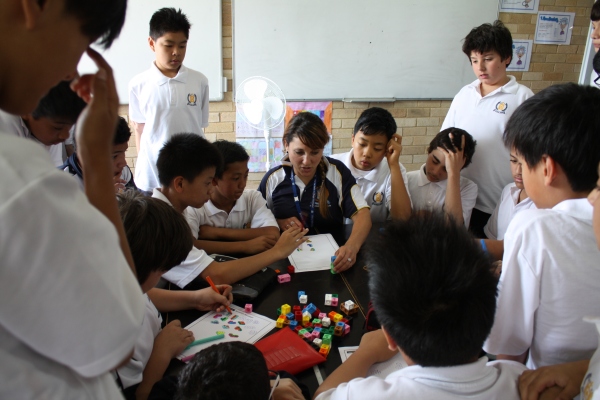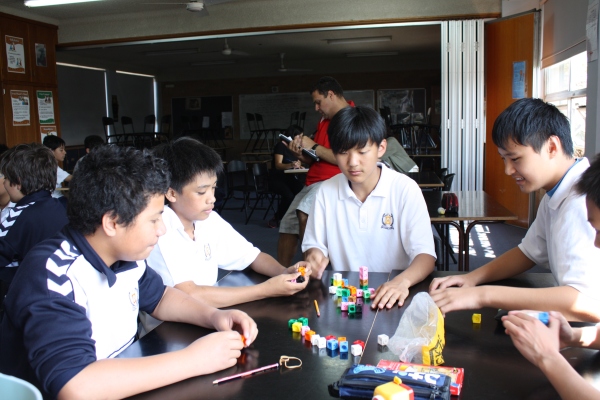Too much time has passed and too many thoughts tumble around in my head – as Tanja Galetti and Megan Graff commented on Edna Sackson‘s blog on reticent bloggers, “I blog in my head all the time.”
The past week has seen a few things I could write about – and hopefully will! The Student Meet at Shore School on the 19th (was a fantastic first of many to come, I’m sure), working my way through a PBL social justice unit (love the topic, struggling to find traction on behalf of other teachers…), and the first classroom observation/Instructional Rounds with a group who have been working towards this throughout the year.
Instructional Rounds is a means of opening classrooms up for observation – with an emphasis on objective description of what is being said and done. It is not an appraisal, or peer coaching as such. There is a great deal of theory, and some pretty important protocols to follow. As detailed in Elmore and City’s text, Instructional Rounds is designed for team members from participating schools to observe and feedback on what they see happening in each others’ schools, thereby supporting professional dialogue and system growth.
I first experienced Instructional Rounds, however, through the generosity of Cameron Paterson who kindly opened the doors of Shore School to allow visiting teachers to participate in the process. At Shore, it is not so much a system support as yet, but certainly a means to take ‘snapshots’ of classroom practice and use these as stimulus for lively dialogue about what we see and hear taking place, and from there to make predictions about what students would be learning as a result. The idea is that a “problem of practice”, something to focus on, is established, with the aim of working out how this is accomplished in the classroom, and then planning the “next work” to meet this aim so that the teacher grows as a professional, and the students benefit.
At my own school, we had been discussing the need to open our classrooms up and watch each other at work. Using a jigsaw reading, the middle leaders explored Instructional Rounds as a means to observe without judgement. The term “problem of practice” was a sticking point as it carried the connotation of working from a ‘deficit’ model. (The term doesn’t worry me, as I have seen Rounds in practice and it certainly is not about deficits, but I was happy to lose the battle to win the war…).We discussed the fluid nature of professional learning, trying, reflecting, evaluating, improving – and agreed to use a “focus area” for observations, but not call it a “problem of practice”.
So how did we get here and what made this week so special? I had used a modified version of IR with a Year 7 team earlier in the year – I was perplexed when it wasn’t as “successful” as those I’d observed at Shore. On reflection, having two experienced teachers observe two new teachers and vice versa meant that suggestions and analysis were hard to avoid – but the debrief was mainly about what we saw, and what the kids would be learning. The beauty was that even though it wasn’t a textbook experience, the teachers continued their dialogue and collegial support of each other.
The Mathematics Coordinator had expressed earlier in the year that one of her professional goals for 2012 was to grow the capacity of her staff to teach effectively at the junior level. The coordinator and one of our young but experienced teachers had attended a workshop in 2011 with Charles Lovitt, focussing on experiential learning and open-ended investigations in Maths. Because our current Year 7 cohort has 105 students, with about 33 having identified special needs, (including quite a few on the autism spectrum), the Year 7 team would need to be able to reach and teach students with a broad range of abilities in mixed ability classes. Whilst all Year 7 teachers have been teaching between 3 and 10 years, one had focussed primarily on seniors and advanced/extension subjects.
N and KG were given some release earlier in the year to plan some concrete learning activities and develop resources to include all students in a range of problem solving activities designed to both remediate and extend number skills, particularly around order of operations. KA and M then had the opportunity to observe the others teaching, but in an informal capacity. The feedback from the observation process was really positive.
We next organised for all four teachers to have a planning day together. The current unit on 2D and 3D shapes had presented stumbling blocks for some students in the past. The teachers worked together to develop a series of lessons that involved constructing, experiencing, observing, and playing with shapes both inside and outside the classroom. Each teacher took responsibility for designing and resourcing a set lesson, and the other three would then observe that lesson.
My role was to organise the time, and to liaise with people to make it happen. I typed up some brief notes on Instructional Rounds, especially regarding protocols and some tips for recording observations (descriptive and objective, not analytical or judgmental; look for “fine grained evidence” as opposed to making general statements). I then briefed the team, they chose roles for the observation, and away we went. KG would focus her observations on what N said and did, M would concentrate on what the students said and did. KA’s role was to wander around and ask the students about their learning.
There are things that look great in theory, but lose something in the execution. And then there are other things that you hope follow the theory, but take on a life of their own and exceed all expectations. And this was what happened here.

Teacher gathers boys around to demonstrate the first of several activities designed to provide the boys with hands on experience in working with 3D shapes.
N’s lesson was brilliant. Her manner with the kids was inviting, she was organised, clear with instructions. The lesson started with fishbowl “meetings” and the kids were told there would be three more during the lesson. When she spoke to the boys, she kneeled down, and made eye contact. The boys were invited to share and give suggestions. After each meeting, teams of four-five boys returned to table groups to manipulate blocks. They co-constructed “houses” made to specifications set by “council”. They later made isometric drawings, colour coded rooms and stories, used terminology such as vertices and faces quite comfortably. They then tabulated the ‘cost’ of their various buildings, and made a quick “brochure” with a cul-de sac, house sketches pasted on, annotated with description and cost. Their housing estates were “named” and brochures submitted (a lot for one lesson, but we have 80 minute lessons, so just squeaked in there…)

Students collaborate to create and compare their 3D shapes, designed to “council” specifications, whilst in the background, a teacher observes the learning.
And the other teachers? We had a quick debrief whilst the kids were in their second round of activities. The kids were focussed and asked questions of each other. It was clear that the lesson was timed, well-planned, the parameters were communicated clearly to the boys and they were reminded throughout and knew what to expect. The teachers were great about recording “fine-grained” and objective evidence (p 93), and they were all actively engaged in carrying out their roles.
Said K of the experience (not of the lesson): “We can learn so much by observing each other. This was just so valuable. I’m a bit nervous about getting feedback when they come to observe me, but it is just so important to see how different people teach and how different people deal with difficult situations.”
At staff briefing, the whole team got a mention and N some well-deserved praise for her work. The rest of the staff have had a peek at IR (albeit in modified form), it got good press, positive word of mouth from all participants… and the coordinator is meeting her goal of growing capacity in her team. We have three more lots of observations to come – each of the four teachers modelling a lesson each week – and we have yet to do a proper debrief. But as far as opening up classrooms and learning from each other, and fostering professional dialogue? A great start and all credit to the four teachers who made it work. Yeah!

Thanks for the post, I have also had the fortune to attend IR at Shore with Cameron.
Starting IR at my school is one of my goals for next year.
Thanks, Phillip. I know this wasn’t IR by the book, but the process of getting into each other’s classrooms and observing practitioners at work is proving to be so valuable… Leads to professional dialogue, collegial sharing. The feedback so far shows it’s non-threatening and the process honours the teacher’s work whilst providing a mirror on practice.
Hey Denise, Thanks for the opportunity to be involved in this, it really is a great learning experience.
KG
Thanks for having a look – has been really brilliant working with you guys – and your feedback to me makes it worth pushing ahead!
Hey Denise, so good to see you sharing your successes (and the teething frustrations). I really enjoyed this blogpost. And thanks as well for supporting the StudentMeet. Your turn next?
Thanks for having a look and taking the time to comment, Cam. It’s one thing to read a book, and quite another to experience Rounds in person. What I loved about our visit to your place was the way to adapted the process for what would give meaning and energy to professional dialogue in your school context. That gave me the confidence to run a modified version, staying true to description, debrief, roles, etc… but it has truly been a springboard for energy around observations/sharing/collegiality. Now to focus on “the next work” so it wasn’t just a feel good, pat on the back, but leads to improvement in key areas. Ta!